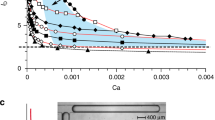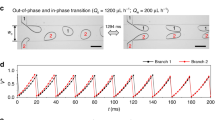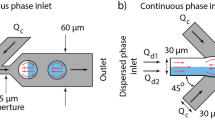Abstract
Droplets forming sequences in simple microfluidic networks are known to exhibit complex behaviours, but their dynamics are yet to be probed in channels long enough to accommodate many droplets simultaneously. Here we show that uniform sequences of liquid droplets flowing through microfluidic networks can spontaneously form ‘trains’ that periodically exchange between different branches of the network. Such system-wide oscillations do not rely on direct droplet–droplet interactions, are common to networks of various topologies, can be controlled or eliminated by adjusting network dimensions and can synchronize into larger flow patterns. The oscillations can also be suppressed via droplet collisions at diverging junctions. This mechanism may explain why red blood cells in microcapillaries exhibit only low-amplitude oscillations, preventing dangerous local hypertension or hypoxia that might otherwise ensue. Our findings are substantiated by a theoretical model that treats droplets as sets of moving points in one-dimensional ducts and captures the dynamics of large droplet ensembles without invoking the microscopic details of flows in or around the droplets. For blood flow, this simplified description offers more realistic estimates than continuous haemodynamic models, indicating the relevance of the discrete nature of blood to the excitation of oscillations.
This is a preview of subscription content, access via your institution
Access options
Access Nature and 54 other Nature Portfolio journals
Get Nature+, our best-value online-access subscription
$29.99 / 30 days
cancel any time
Subscribe to this journal
Receive 12 print issues and online access
$209.00 per year
only $17.42 per issue
Buy this article
- Purchase on Springer Link
- Instant access to full article PDF
Prices may be subject to local taxes which are calculated during checkout





Similar content being viewed by others
Data availability
The data that support the plots within this paper and other findings of this study are available from the corresponding authors upon request.
Code availability
The computer codes used for simulations are available from the corresponding authors upon request.
References
Wang, X., Lai, Y.-C. & Lai, C. H. Oscillations of complex networks. Phys. Rev. E 74, 66104 (2006).
Li, P., Yi, Z. & Zhang, L. Global synchronization of a class of delayed complex networks. Chaos Solitons Fractals 30, 903–908 (2006).
Jin, W.-L. & Zhang, Y. Paramics simulation of periodic oscillations caused by network geometry. Transp. Res. Rec. J. Transp. Res. Board 1934, 188–196 (2005).
Nie, Y. & Zhang, H. M. Oscillatory traffic flow patterns induced by queue spillback in a simple road network. Transp. Sci. 42, 236–248 (2008).
Mauch, M. & Cassidy, M. J. in Transportation and Traffic Theory in the 21 st Century (ed. Taylor, M. A. P.) 653–673 (Emerald Group Publishing, 2002).
Ahn, S., Laval, J. & Cassidy, M. Effects of merging and diverging on freeway traffic oscillations. Transp. Res. Rec. J. Transp. Res. Board 2188, 1–8 (2010).
Davis, J. M. & Pozrikidis, C. Numerical simulation of unsteady blood flow through capillary networks. Bull. Math. Biol. 73, 1857–1880 (2011).
Geddes, J. B., Carr, R. T., Karst, N. J. & Wu, F. The onset of oscillations in microvascular blood flow. SIAM J. Appl. Dyn. Syst. 6, 694–727 (2007).
Zhang, L. & Clark, D. D. Oscillating behavior of network traffic: a case study simulation. J. Internetworking Res. Exp 1, 101–112 (1990).
Wang, Z., Wang, Z. & Crowcroft, J. Analysis of shortest-path routing algorithms in a dynamic network environment. ACM Comput. Commun. Rev. 22, 63–71 (1992).
Kaminski, T. S., Churski, K. & Garstecki, P. Microdroplet Technology (Springer, 2012).
Mashaghi, S., Abbaspourrad, A., Weitz, D. A. & Van Oijen, A. M. Droplet microfluidics: a tool for biology, chemistry and nanotechnology. TrAC Trends Anal. Chem. 82, 118–125 (2016).
Chou, W.-L., Lee, P.-Y., Yang, C.-L., Huang, W.-Y. & Lin, Y.-S. Recent advances in applications of droplet microfluidics. Micromachines 6, 1249–1271 (2015).
Popel, A. S. & Johnson, P. C. Microcirculation and hemorheology. Annu. Rev. Fluid Mech. 37, 43–69 (2005).
Pries, A. R., Secomb, T. W., Gaehtgens, P. & Gross, J. F. Blood flow in microvascular networks. Experiments and simulation. Circ. Res. 67, 826–834 (1990).
Kiani, M. F., Pries, A. R., Hsu, L. L., Sarelius, I. H. & Cokelet, G. R. Fluctuations in microvascular blood flow parameters caused by hemodynamic mechanisms. Am. J. Physiol. 266, H1822–H1828 (1994).
Forouzan, O., Yang, X., Sosa, J. M., Burns, J. M. & Shevkoplyas, S. S. Spontaneous oscillations of capillary blood flow in artificial microvascular networks. Microvasc. Res. 84, 123–132 (2012).
Podgoreanu, M. V., Stout, R. G., El-Moalem, H. E. & Silverman, D. G. Synchronous rhythmical vasomotion in the human cutaneous microvasculature during nonpulsatile cardiopulmonary bypass. Anesthesiology 97, 1110–1117 (2002).
Palmer, A. F. & Intaglietta, M. Blood substitutes. Annu. Rev. Biomed. Eng. 16, 77–101 (2014).
Schindler, M. & Ajdari, A. Droplet traffic in microfluidic networks: a simple model for understanding and designing. Phys. Rev. Lett. 100, 44501 (2008).
Amon, A., Schmit, A., Salkin, L., Courbin, L. & Panizza, P. Path selection rules for droplet trains in single-lane microfluidic networks. Phys. Rev. E 88, 13012 (2013).
Cybulski, O. & Garstecki, P. Dynamic memory in a microfluidic system of droplets traveling through a simple network of microchannels. Lab Chip 10, 484–493 (2010).
Glawdel, T., Elbuken, C. & Ren, C. Passive droplet trafficking at microfluidic junctions under geometric and flow asymmetries. Lab Chip 11, 3774–3784 (2011).
Sessoms, D. A., Amon, A., Courbin, L. & Panizza, P. Complex dynamics of droplet traffic in a bifurcating microfluidic channel: periodicity, multistability and selection rules. Phys. Rev. Lett. 105, 154501 (2010).
Parthiban, P. & Khan, S. A. Filtering microfluidic bubble trains at a symmetric junction. Lab Chip. 12, 582–588 (2012).
Maddala, J., Vanapalli, S. A. & Rengaswamy, R. Origin of periodic and chaotic dynamics due to drops moving in a microfluidic loop device. Phys. Rev. E 89, 23015 (2014).
Wang, W. S. & Vanapalli, S. A. Millifluidics as a simple tool to optimize droplet networks: case study on drop traffic in a bifurcated loop. Biomicrofluidics 8, 64111 (2014).
Glawdel, T. & Ren, C. Global network design for robust operation of microfluidic droplet generators with pressure-driven flow. Microfluid. Nanofluid. 13, 469–480 (2012).
Djalali Behzad, M. et al. Simulation of droplet trains in microfluidic networks. Phys. Rev. E 82, 37303 (2010).
Smith, B. J. & Gaver, D. P. III Agent-based simulations of complex droplet pattern formation in a two-branch microfluidic network. Lab Chip 10, 303–312 (2010).
Maddala, J. & Rengaswamy, R. Design of multi-functional microfluidic ladder networks to passively control droplet spacing using genetic algorithms. Comput. Chem. Eng. 60, 413–425 (2014).
Kasule, J. S., Maddala, J., Mobed, P. & Rengaswamy, R. Very large scale droplet microfluidic integration (VLDMI) using genetic algorithm. Comput. Chem. Eng. 85, 94–104 (2016).
Kadivar, E., Herminghaus, S. & Brinkmann, M. Droplet sorting in a loop of flat microfluidic channels. J. Phys. Condens. Matter 25, 285102 (2013).
Jeanneret, R., Vest, J.-P. & Bartolo, D. Hamiltonian traffic dynamics in microfluidic loop networks. Phys. Rev. Lett. 108, 34501 (2012).
Choi, W. et al. Bubbles navigating through networks of microchannels. Lab Chip 11, 3970–3978 (2011).
Champagne, N., Vasseur, R., Montourcy, A. & Bartolo, D. Traffic jams and intermittent flows in microfluidic networks. Phys. Rev. Lett. 105, 44502 (2010).
Parthiban, P. & Khan, S. A. Bistability in droplet traffic at asymmetric microfluidic junctions. Biomicrofluidics 7, 44123 (2013).
Churski, K., Nowacki, M., Korczyk, P. M. & Garstecki, P. Simple modular systems for generation of droplets on demand. Lab Chip 13, 3689–3697 (2013).
Hoang, D. A., van Steijn, V., Portela, L. M., Kreutzer, M. T. & Kleijn, C. R. Benchmark numerical simulations of segmented two-phase flows in microchannels using the volume of fluid method. Comput. Fluids 86, 28–36 (2013).
Jakiela, S., Makulska, S., Korczyk, P. & Garstecki, P. Speed of flow of individual droplets in microfluidic channels as a function of the capillary number, volume of droplets and contrast of viscosities. Lab Chip 11, 3603–3608 (2011).
Labrot, V., Schindler, M., Guillot, P., Colin, A. & Joanicot, M. Extracting the hydrodynamic resistance of droplets from their behavior in microchannel networks. Biomicrofluidics 3, 12804 (2009).
Cybulski, O., Jakiela, S. & Garstecki, P. Between giant oscillations and uniform distribution of droplets: the role of varying lumen of channels in microfluidic networks. Phys. Rev. E 92, 063008 (2015).
Pries, A. R. & Secomb, T. W. Microvascular blood viscosity in vivo and the endothelial surface layer. Am. J. Physiol. Heart Circ. Physiol. 289, H2657–H2664 (2005).
Balogh, P. & Bagchi, P. Direct numerical simulation of cellular-scale blood flow in 3D microvascular networks. Biophys. J. 113, 2815–2826 (2017).
Balogh, P. & Bagchi, P. Analysis of red blood cell partitioning at bifurcations in simulated microvascular networks. Phys. Fluids 30, 051902 (2018).
Buchin, V. A. & Shadrina, N. K. Regulation of the lumen of a resistance blood vessel by mechanical stimuli. Fluid Dyn. 45, 211–222 (2010).
Acknowledgements
O.C. and B.A.G. acknowledge support from the Institute for Basic Science Korea, project code IBS-R020-D1. P.G. was supported by the European Research Council starting grant 279647 and by the National Science Centre Symfonia grant (DEC2014/12/W/NZ6/00454).
Author information
Authors and Affiliations
Contributions
O.C. conceived the idea and performed experiments and simulations. P.G. and B.A.G. supervised and guided the research. All authors participated in the writing of the manuscript.
Corresponding authors
Ethics declarations
Competing interests
The authors declare no competing interests.
Additional information
Journal peer review information: Nature Physics thanks Carolyn Ren and the other anonymous reviewer(s) for their contribution to the peer review of this work.
Publisher’s note: Springer Nature remains neutral with regard to jurisdictional claims in published maps and institutional affiliations.
Supplementary information
Supplementary Information
Supplementary Information, Supplementary Figs. 1–10 and Supplementary Refs. 1–9.
Supplementary Video 1
Onset of oscillations in the system from Fig. 1. Droplets of water (dyed blue) suspended in hexane (dyed yellow) flow into the network, which is initially filled solely with hexane. At the beginning, the droplets distribute uniformly all over the network. Subsequently, longer and longer droplet sequences develop with clear oscillations between the two branches visible from approximately 1 min 5 s.
Supplementary Video 2
Oscillations in networks of the same topology as in Fig. 1 and Supplementary Video 1, with three different cross-sections of channels. Original frames from experiments are shown side by side with false-colour images for improved visibility of channels. See Supplementary Section 2 for a detailed description.
Supplementary Video 3
Accelerated (5×) record of the system from Fig. 2a–c, before, during and after blocking the bridge using a plug of very viscous liquid (red dyed glycerol). Oscillations occur when the bridge is blocked—the variation of pressure accompanying them makes the plug move back and forth. After removing the plug, the oscillations disappear.
Supplementary Video 4
System from Fig. 2d–f. The first part of the video shows version without transverse bridges (see Fig. 2d). The second part shows the stationary state of the system with bridges (see Fig. 2e).
Supplementary Video 5
Stationary state (oscillations) of the system shown in Fig. 3a (top) alongside with corroborating simulation (bottom panel) from Fig. 3c.
Supplementary Video 6
Stationary oscillations of the system shown in Fig. 3b (experiment, top panel) and Fig. 3d (simulation, bottom panel), that is, of the same microfluidic chip as in Supplementary Video 5 and Figs. 3a,c, but traversed in the opposite direction.
Supplementary Video 7
Visualization of short fragments of simulations of variously routed versions of the network from Supplementary Fig. 9a, each encompassing a single cycle of oscillation. Sequence of digits in the lower left corner shows the currently presented connectivity and direction of flow. Selected sequences are 01234567, 01452367, 02134567, 02143567, 02361457 and 04263517, each traversed in both directions.
Supplementary Video 8
Impact of mutual collisions between two droplets at the area of a diverging T-junction on the selection of a branch the trailing droplet enters. Initially, flow rate in the left branch is larger than that in the right, so that the majority of incoming droplets turn left. However, every eighth interval between subsequent droplets is shorter, causing these two droplets to collide at the area of the junction, and redirecting the trailing droplet into the opposite branch. Flow difference between branches gradually decreases, becoming negative in the middle of the movie. From this moment on, most droplets turn to the right, whereas the droplets ‘scattered’ off their predecessors turn left.
Supplementary Video 9
Mutual collisions between droplets as a tool for controlling oscillations. As long as droplets are generated pairwise (that is, with alternating short and long intervals), droplets from each pair are directed to two different branches of the network. Consequently, droplets are distributed uniformly all over the network. Upon switching to generation of droplets with constant intervals (the average distance between droplets remains the same), the oscillations slowly arise, reaching the stationary state within a few minutes. Then, pairwise droplet generation is turned on again, leading to systematic (but not immediate) suppression of oscillations. The system comes back to the uniform distribution of droplets.
Rights and permissions
About this article
Cite this article
Cybulski, O., Garstecki, P. & Grzybowski, B.A. Oscillating droplet trains in microfluidic networks and their suppression in blood flow. Nat. Phys. 15, 706–713 (2019). https://doi.org/10.1038/s41567-019-0486-8
Received:
Accepted:
Published:
Issue Date:
DOI: https://doi.org/10.1038/s41567-019-0486-8
This article is cited by
-
Transport and retention of silica nanoparticles in glass-bead columns: effects of particle size, type, and concentration of ionic species
Scientific Reports (2024)
-
Revolutionizing the female reproductive system research using microfluidic chip platform
Journal of Nanobiotechnology (2023)
-
Numerical Modelling for the Droplets Formation in Microfluidics - A Review
Microgravity Science and Technology (2023)
-
Perfusion and endothelialization of engineered tissues with patterned vascular networks
Nature Protocols (2021)
-
Breakup a droplet passing through an obstacle in an orthogonal cross-section microchannel
Theoretical and Computational Fluid Dynamics (2021)



